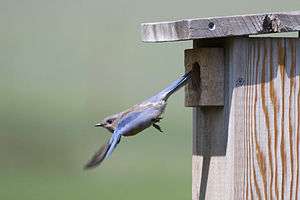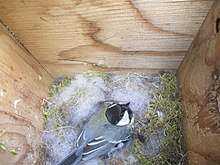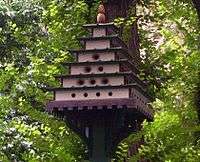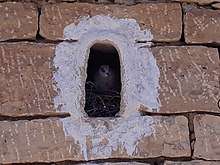Nest box
A nest box, also spelled nestbox, is a man-made enclosure provided for animals to nest in. Nest boxes are most frequently utilized for birds, in which case they are also called birdhouses or a birdbox/bird box, but some mammalian species such as bats may also use them. Placing nestboxes or roosting boxes may also be used to help maintain populations of particular species in an area. The modern nest box was invented by the British conservationist Charles Waterton in the early 19th century to encourage more birdlife and wildfowl on the nature reserve he set up on his estate.[1]

Traditional nest boxes have existed in many civilisations, since antiquity.
Nest boxes are getting more attention because industrialization, deforestation and other human activities since the mid-20th century have caused severe declines in birds' natural habitats, introducing hurdles to breeding. A nest box can help prevent bird extinction.[2]
Construction
General construction

Nest boxes are usually wooden, although the purple martin will nest in metal.[3] Some boxes are made from a mixture of wood and concrete, called woodcrete.[4] Ceramic and plastic nestboxes are not suitable.[5]
Nest boxes should be made from untreated wood with an overhanging, sloped roof, a recessed floor, drainage and ventilation holes, a way to access the interior for monitoring and cleaning, and have no outside perches which could assist predators.[6] Boxes may either have an entrance hole or be open-fronted.[7] Some nest boxes can be highly decorated and complex, sometimes mimicking human houses or other structures. They may also contain nest box cameras so that use of, and activity within, the box can be monitored.[8]
Bird nest box construction

| Wikimedia Commons has media related to Birdhouse. |
The diameter of the opening in a nest-box has a very strong influence on the species of birds that will use the box. Many small birds select boxes with a hole only just large enough for an adult bird to pass through. This may be an adaptation to prevent other birds from raiding it. In European countries, an opening of 2.5 cm in diameter will attract Poecile palustris, Poecile montanus; an opening of 2.8 cm in diameter will attract Ficedula hypoleuca, and an opening of 3 cm in diameter will attract Parus major, Passer montanus, an opening of 3.2 cm in diameter will attract Passer domesticus.[9]
The size of the nest box also affects the bird species likely to use the box. Very small boxes attract wrens and treecreepers and very large ones may attract ducks and owls. Seasonally removing old nest material and parasites is important if they are to be successfully re-used.
The material used in the construction may also be significant. Sparrows have been shown to prefer woodcrete boxes rather than wooden ones. Birds nesting in woodcrete sites had earlier clutches, a shorter incubation period, and more reproductive success, perhaps because the synthetic nests were warmer than their wooden counterparts.[10]
Placement of the nest box is also significant. Some birds (including birds of prey[11][12]) prefer their nest box to be at a particular height, while others (such as ducks) may prefer them to be very low or even at ground level. Orientation relative to the sun is also important, with many birds preferring their boxes to be away from direct sun and sheltered from the prevailing rain.[13]
Bat box construction
.jpg)
| Wikimedia Commons has media related to Bat houses. |
Bat boxes differ from bird nest-boxes in typical design, with the larger opening on the underside of the box, and are more often referred to as bat boxes, although in regard to the rearing of young, they serve the same purpose. Some threatened bat species can be locally supported with the provision of appropriately placed bat-boxes, however species that roost in foliage or large cavities will not use bat boxes. Bat boxes are typically made out of wood, and there are several designs for boxes with single or multiple chambers. Directions for making the open bottom bat houses for small and large colonies,[14][15] as well as locations to purchase them are available on the internet.[16] Colour and placement is important to ensuring that bat boxes are used; bat boxes that are too shaded will not heat up enough to attract a maternity colony of bats. Australian bat box projects have been running for over 12 years in particular at the Organ Pipes National Park. Currently there are 42 roost boxes using the "Stebbings Design" which have peaked at 280 bats roosting in them. The biggest problem with roosting boxes of any kind is the ongoing maintenance; problems include boxes falling down, wood deteriorating, and pests such as ants, the occasional rat, possums, and spiders.[17]
Other creatures

Nest boxes are marketed not only for birds, but also for butterflies,[18][19] mammals, especially arboreal ones such as squirrels and opossums. Depending on the animal, these boxes may be used for roosting, breeding, or both, or, as in the case with butterflies, hibernation.[19]
Wasps, bumble-bees, or other insects may build their nests inside a nest box intended for other animals, and may exclude the intended species.[20]
See also
- Biological pest control: birds can help controlling pests in agriculture; section also details the planting of food crops for birds
- Artificial bird nests
References
- "Charles Waterton (1782–1865)". Birdhouse Planet. Retrieved 2018-08-29.
- "Birdhouse Basics – Birdhouse Planet". Birdhouse Planet. Retrieved 2018-08-29.
- "Before Buying a Birdhouse". Duncraft's Wild Bird Blog. 2010-03-10. Retrieved 12 March 2014.
- Browne, Stephen J. (2006-07-01). "Effect of nestbox construction and colour on the occupancy and breeding success of nesting tits Parus spp". Bird Study. 53 (2): 187–192. doi:10.1080/00063650609461432. ISSN 0006-3657.
- "Details". The RSPB.
- "Attracting Birds With Nest Boxes". The Cornell Lab of Ornithology. Cornell University. Retrieved 12 March 2014.
- "Putting up a nest box | BTO - British Trust for Ornithology". www.bto.org. Retrieved 2017-03-05.
- Phillips, Tina; Cooper, Caren. "Lights, Camera, Action! Nest Box Cam technology reveals rarely seen events". Cornell Lab of Ornithology. Cornell University. Retrieved 12 March 2014.
- Pauline Pears (2005), HDRA encyclopedia of organic gardening, Dorling Kindersley, ISBN 978-1405308915
- García-Navas, Vicente; Arroyo, Luis; Sanz, Juan José; Díaz, Mario (2008). "Effect of nestbox type on occupancy and breeding biology of tree sparrows Passer montanus in central Spain". Ibis. 150 (2): 356–364. doi:10.1111/j.1474-919X.2008.00799.x. hdl:10261/110551. Archived from the original (PDF) on 2010-09-30.
- "Falcon nest box position". Archived from the original on 2017-05-16.
- "Various nest box designs (various species)".
- "Siting a nest-box". RSPB.
- "Single chamber bat house (wall mounted)". Bat Conservation International. Archived from the original on 2007-10-31. Retrieved 2007-11-17.
- Brown, Carla. "Why I Built A Bat House". National Wildlife Federation. Archived from the original on 2007-11-24. Retrieved 2007-11-17.
- Boleky, Vaughan (2005–2006). "Why Are Bat Houses Important?". Organization for Bat Conservation. Archived from the original on 2007-11-10. Retrieved 2007-11-17.
- Tuttle, Merlin D.; Kiser, Mark; Kiser, Selena (2013). The Bat House Builder's Handbook (PDF). Bat Conservation International. Archived from the original (PDF) on 2016-04-19. Retrieved 2016-10-19.
- Johnson, Terry W. "Out My Backdoor: Do Butterfly Boxes Work?". Out My Backdoor. GA DEPARTMENT OF NATURAL RESOURCES. Retrieved 17 December 2018.
- Bergström, Nina (2011-06-19). "Fixa fint för fjärilarna". Expressen (in Swedish). Archived from the original on 2011-06-19. Retrieved 28 June 2011.
- "Managing Nest Box Competitors". Nest Watch. Retrieved 2014-09-12.
External links
| Wikimedia Commons has media related to Nest boxes. |
- "Nest box page". Royal Society for the Protection of Birds.
- "Birds Australia Information Sheet 5: Nestboxes for Natives" (PDF). Archived from the original (PDF) on 2009-09-16.
- McDonald, Rob (12 July 2006). "Birdhouses". Southern Spaces.



